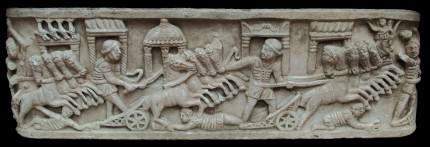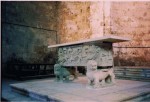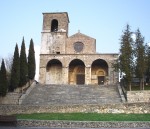
An exquisite yellow marble sarcophagus carved in high relief with quadrigae (four-horse chariots) racing at the Circus Maximus has been returned to its hometown of Aquino, about 60 miles south of Rome, 21 years after it was stolen from the Church of Santa Maria della Libera. The sarcophagus, a masterpiece of Roman funerary art from the late second to third century A.D., had been used as the church’s central altar since 1948 where it remained without incident until 1991.
Thieves, taking advantage of renovations on site, first stole it in August of 1991, but it was immediately found and brought back to the church. That turned out not to be the wisest of choices. During the night of September 2-3, 1991, thieves stole the sarcophagus again and this time it disappeared into the dark channels of the antiquities trade.
 Authorities searched high and low for the piece, publishing pictures of it on international lists of stolen works, but some of the details were wrong (the material was listed as alabaster instead of marble and the dimensions were inaccurate). Still, it’s not like there are dozens of sarcophagi just like this one floating around. It’s entirely one of a kind. Yet, for 20 years it was nowhere to be found.
Authorities searched high and low for the piece, publishing pictures of it on international lists of stolen works, but some of the details were wrong (the material was listed as alabaster instead of marble and the dimensions were inaccurate). Still, it’s not like there are dozens of sarcophagi just like this one floating around. It’s entirely one of a kind. Yet, for 20 years it was nowhere to be found.
Last summer, the state prosecutor’s office was contacted by the executor of the estate of a recently deceased collector/antiquities trafficker who had apparently purchased the sarcophagus in 1991 for around one million dollars. The piece was the star of this unnamed person’s London collection, a collection that was in danger of being split up between two more unnamed collectors, one Russian and one American. The executor wanted to see the sarcophagus returned to Italy before the collection was broken up, so he reached out to state prosecutor Maurizio Fiorilli who has been at the forefront of Italy’s legal campaign against looting and the dealers and curators who finance it.
Fiorilli alerted the Archaeological Patrimony squad of the Guardia di Finanza (an Italian law enforcement agency that focuses on financial crimes), and Operation Juvenal, named after the late 1st/early 2nd century Roman satirical poet who was born in Aquino, was launched. The Guardia di Finanza secured a warrant to seize the artifact in London. There was a condition, though. The executor of the estate would voluntarily return the sarcophagus to the Italian embassy in London only if its deceased owner could remain anonymous. The police and prosecutor agreed, and on April 16th, 2012, a large box containing the sarcophagus was delivered to the embassy. There was no return address or name of sender on the box.
We don’t know who this collector was. The cops aren’t talking as investigations are ongoing. Rumor has it the culprit was high society antiquities dealer/thief/fence Robert Hecht, who was on trial in Italy for antiquities trafficking from 2005 until the statute of limitations ran out in January of 2012, but it doesn’t seem to me that the particulars fit. He died in February, just a month after his case was dropped, so it would be odd for the executor of his estate to be contacting the authorities last summer, especially since he was still on trial then. Wouldn’t any haggling have been up to his criminal attorneys? Also, he died in Paris, not London. Also, he had quality contacts among the looters and middlemen of Italy. I doubt he would have paid a million dollars in the first place, and certainly not unless he had a museum curator with five million dollars burning a hole in his or her pocket.
 Two months after its arrival at the Italian embassy in London, the sarcophagus was sent to Rome on a cargo flight, escorted by Guardia di Finanza commander Massimo Rossi and his gendarmes. It arrived the evening of Wednesday, July 18th. The next day it was revealed in all its glory at a press conference in Rome, and then trucked to Aquino where it was greeted with tears of joy by the locals who had given up hope that they’d ever see it again.
Two months after its arrival at the Italian embassy in London, the sarcophagus was sent to Rome on a cargo flight, escorted by Guardia di Finanza commander Massimo Rossi and his gendarmes. It arrived the evening of Wednesday, July 18th. The next day it was revealed in all its glory at a press conference in Rome, and then trucked to Aquino where it was greeted with tears of joy by the locals who had given up hope that they’d ever see it again.
 For security reasons, the sarcophagus is being kept in the city museum rather than in the church. The mayor of Aquino, Antonino Grincia, says they hope to be able to return the sarcophagus to the church, “its natural home,” when conditions permit. One hopes that means some sort of anti-theft system is in place, but there are no specifics at the moment.
For security reasons, the sarcophagus is being kept in the city museum rather than in the church. The mayor of Aquino, Antonino Grincia, says they hope to be able to return the sarcophagus to the church, “its natural home,” when conditions permit. One hopes that means some sort of anti-theft system is in place, but there are no specifics at the moment.
 You might wonder how a sarcophagus depicting a not even remotely Christian chariot race is naturally at home in a church, and as its central altar, no less. The answer is this church is a beautiful example of austere Romanesque architecture, built in the 11th century over the ruins of the Temple of Hercules Liberator (hence Santa Maria della Libera) from marble scavenged off of the many ancient structures in town, including the temple itself. The walls are packed with decorative marble bits and bobs, epigraphs, cornices, funerary reliefs, and metopes (the flat rectangles between decorated pieces of a frieze). I’ve seen a lot of churches made out of a lot of recycled Roman marble, but this collage style is really something special. You can observe the beautifully severe jumble of antiquity and Middle Ages in this YouTube video.
You might wonder how a sarcophagus depicting a not even remotely Christian chariot race is naturally at home in a church, and as its central altar, no less. The answer is this church is a beautiful example of austere Romanesque architecture, built in the 11th century over the ruins of the Temple of Hercules Liberator (hence Santa Maria della Libera) from marble scavenged off of the many ancient structures in town, including the temple itself. The walls are packed with decorative marble bits and bobs, epigraphs, cornices, funerary reliefs, and metopes (the flat rectangles between decorated pieces of a frieze). I’ve seen a lot of churches made out of a lot of recycled Roman marble, but this collage style is really something special. You can observe the beautifully severe jumble of antiquity and Middle Ages in this YouTube video.
 The sarcophagus was actually discovered on the church site during a 19th century excavation. After its initial discovery, the sarcophagus was moved to the nearby palace of the seminary where it was put on display in the atrium. The palace was damaged by Allied bombing in 1944, so after the war the sarcophagus was moved to the church which had survived the war just like it had survived the previous thousand years. Towards the beginning of those thousand years, incidentally, Saint Thomas Aquinas (1225-1274), Doctor Angelicus, author of the Summa Theologica, was baptized in that very church. Aquinas is a Latin demonym meaning “from Aquino.”
The sarcophagus was actually discovered on the church site during a 19th century excavation. After its initial discovery, the sarcophagus was moved to the nearby palace of the seminary where it was put on display in the atrium. The palace was damaged by Allied bombing in 1944, so after the war the sarcophagus was moved to the church which had survived the war just like it had survived the previous thousand years. Towards the beginning of those thousand years, incidentally, Saint Thomas Aquinas (1225-1274), Doctor Angelicus, author of the Summa Theologica, was baptized in that very church. Aquinas is a Latin demonym meaning “from Aquino.”